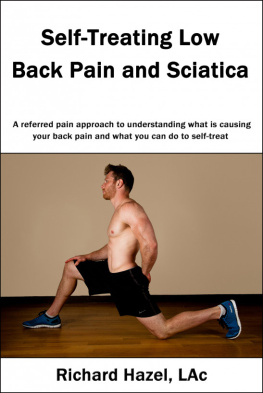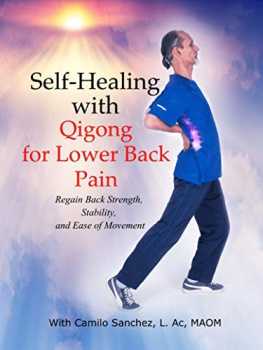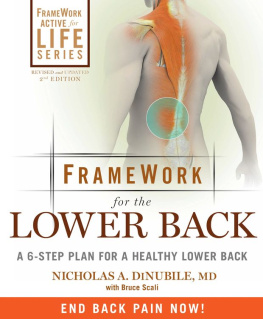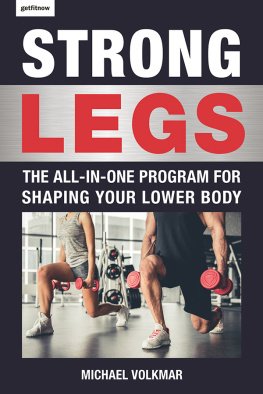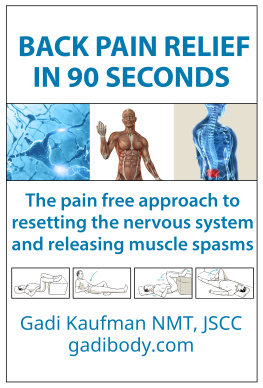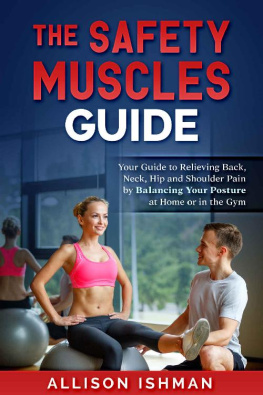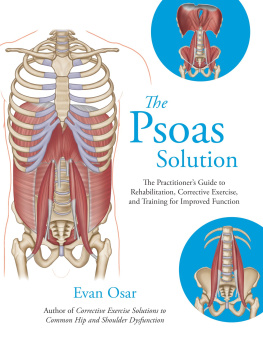Front Matter
Landmarks

The Vital
Psoas Muscle
Connecting Physical, Emotional, and Spiritual Well-Being
Jo Ann Staugaard-Jones

Copyright 2012 by Jo Ann Staugaard-Jones. All rights reserved. No portion of this book, except for brief reviews, may be reproduced, stored in a retrieval system, or transmitted in any form or by any means electronic, mechanical, photocopying, recording, or otherwise without the written permission of the publisher. For information, contact Lotus Publishing or North Atlantic Books.
First published in 2012 by
Lotus Publishing
Apple Tree Cottage, Inlands Road, Nutbourne, Chichester, PO18 8RJ and
North Atlantic Books
P. O. Box 12327
Berkeley, California 94712
Drawings Amanda Williams, Pascale Pollier
Text Design Wendy Craig
Cover Design Paula Morrison
Printed and bound in Singapore by Tien Wah Press
The Vital Psoas Muscle: Connecting Physical, Emotional, and Spiritual Well-Being is sponsored by the Society for the Study of Native Arts and Sciences, a nonprofit educational corporation whose goals are to develop an educational and cross-cultural perspective linking various scientific, social, and artistic fields; to nurture a holistic view of arts, sciences, humanities, and healing; and to publish and distribute literature on the relationship of mind, body, and nature.
British Library Cataloguing-in-Publication Data
A CIP record for this book is available from the British Library
ISBN 978 1 905367 24 5 (Lotus Publishing)
ISBN 978 1 58394 458 5 (North Atlantic Books)
Library of Congress Cataloguing-in-Publication Data
Staugaard-Jones, Jo Ann.
The vital psoas muscle: connecting physical, emotional, and spiritual well-being / Jo Ann Staugaard-Jones.
p. ; cm.
Includes bibliographical references.
Summary: Full-color alternative approach to understanding and balancing the most important skeletal muscle in the body, aimed at the layperson as well as the professional body practitioner concerned with core strengthening and psoas-related back, hip, knee, and pelvic tension issues--Provided by publisher.
ISBN 978-1-58394-458-5
I. Title.
[DNLM: 1. Lumbosacral Region--physiology. 2. Psoas Muscles--physiology. 3. Exercise Movement Techniques. 4. Mind-Body Therapies. 5. Muscle Stretching Exercises. WE 750]
613.718--dc23
2011036026
Contents
Foreword
I have had the pleasure of knowing and working with Jo Ann for approximately ten years and have the utmost respect for someone who epitomizes health and fitness in thought, word, and deed. She has touched many lives as a teacher and professor, and again as an author in writing her second book. When she asked me to contribute to this book, I was both humbled and honored. When she told me the topic of the book, I was excited. Having spent over 24 years in clinical practice, I have my share of psoas stories and I clearly knew the importance of this often-overlooked muscle. However, after reading the book, I was again humbled at my limited knowledge of how all-encompassing this muscle is. Being in active clinical practice, I love courses and books that have a profound impact on my thinking and that influence the way I treat my patients Monday morning. The Vital Psoas Muscle is most definitely one of those books.
The psoas muscle can be considered a realtors dream, in that its all about location, location, location ! Due to its location, the psoas has the unique distinction of being the only muscle that connects the upper body to the lower body. Therefore the functional ramifications are vast, with the muscle acting as either a prime mover of the action or a critical stabilizer in concert with other prime movers. So whether the movement is lower-quarter driven in a function such as walking, or more upper-quarter driven in a movement such as throwing a ball or reaching upward to an overhead cabinet, the psoas is working. Many clinicians respect the ability of the psoas to function as a prime mover involved in hip flexion; however, despite knowing its proximal attachments to the anterior aspects of the lumbar spine and numerous fascial relationships, they often overlook its function as a stabilizer , as well as its ability to profoundly affect posture.
The location of the psoas also affords it the ability to influence circulation , due to its anatomic proximity to vascular structures, particularly the aorta and the external iliac artery and its continuation into the femoral artery through the complex ilioinguinal area. The psoas possesses crucial fascia connections to support numerous visceral structures and organs. These same organs, through muscular contraction of the psoas, can be stimulated and massaged and subsequently exert influences on the digestion, excretion/elimination, detoxification, and even reproduction processes of the body. The psoas affects respiration via its anatomic relationship with the diaphragm in the area of the solar plexus, which also then influences energy flow throughout the body through its geographic relationship to the lower three chakras of yoga philosophy. Jo Ann does a beautiful job of touching upon the psoass influence on such topics as visceral messaging and somatic memory, as well as the emotional component associated with our gut feelings.
Jo Ann addresses the meaning of wheel for the word chakra . It would not be inconceivable to place the psoas as the hub of that wheel, with a few of the many spokes that are driven and influenced by that hub being our upper body, lower body, core, physiologic and metabolic functions, emotions, spirit, and energy, to name just a few. She has also educated us that the historical meaning of chakra is to bring about a new age. After digesting and assimilating the factual information, as well as offering a functional demonstration of the corrective, rebalancing exercises and practices, our author has provided us with a valuable roadmap for the restoration of harmony between the mind, body, and spirit through this deeply hidden treasure known as the psoas. I think clinicians, anatomists, bio-mechanists, exercise specialists, massage therapists, and others will most certainly be brought to a new age of awareness, recognition, acceptance, and respect for this deeply centered muscles ability to concomitantly affect the mind, the body, and the spirit. It is a widely held belief that only through the balance of all three can optimal health be achieved.
My final reflection is on Jo Anns indication that as the universe is interrelated, so is our body; we are life forms constantly evolving. This book has enlightened and assisted me in my own personal and professional evolutionary process, and I feel that any reader, after taking this journey with the author, will be able to add a layer of knowledge and enlightenment on their own path to a better understanding of optimal health and function.
In health,
Dr. Gary Mascilak , D.C., P.T., C.S.C.S
Introduction
The Vital Psoas Muscle was written because it explains the only muscle in the human organism that connects the upper body to the lower body. Most people are not actually aware of how important this is.
In teaching and researching the psoas as a major force in the body, I began a journey from the kinesiological point of view, into the realm of body flow, energies, and proprioception. This experience has humbled me.
Physically: As a movement specialist I found the mechanics documented, as recently as a year ago, in a state of flux as to psoas actions and roles. Renowned psoas experts are constantly updating information to help sort everything out. The most simplified statement is this: the psoas is complicated . No longer will I call the psoas a major mover of hip flexion, except as part of the iliopsoas muscle group, where the iliacus is the stronger flexor in most cases. In the lumbar spine, there are other muscles that remain the more powerful flexors, mainly the rectus abdominis. The roles of the psoas major as both a lumbar spine and hip stabilizer and a connector to the lower extremity appear more important mechanically and warrant its significance, yet its stabilizing functions are still in question depending on the movement.


